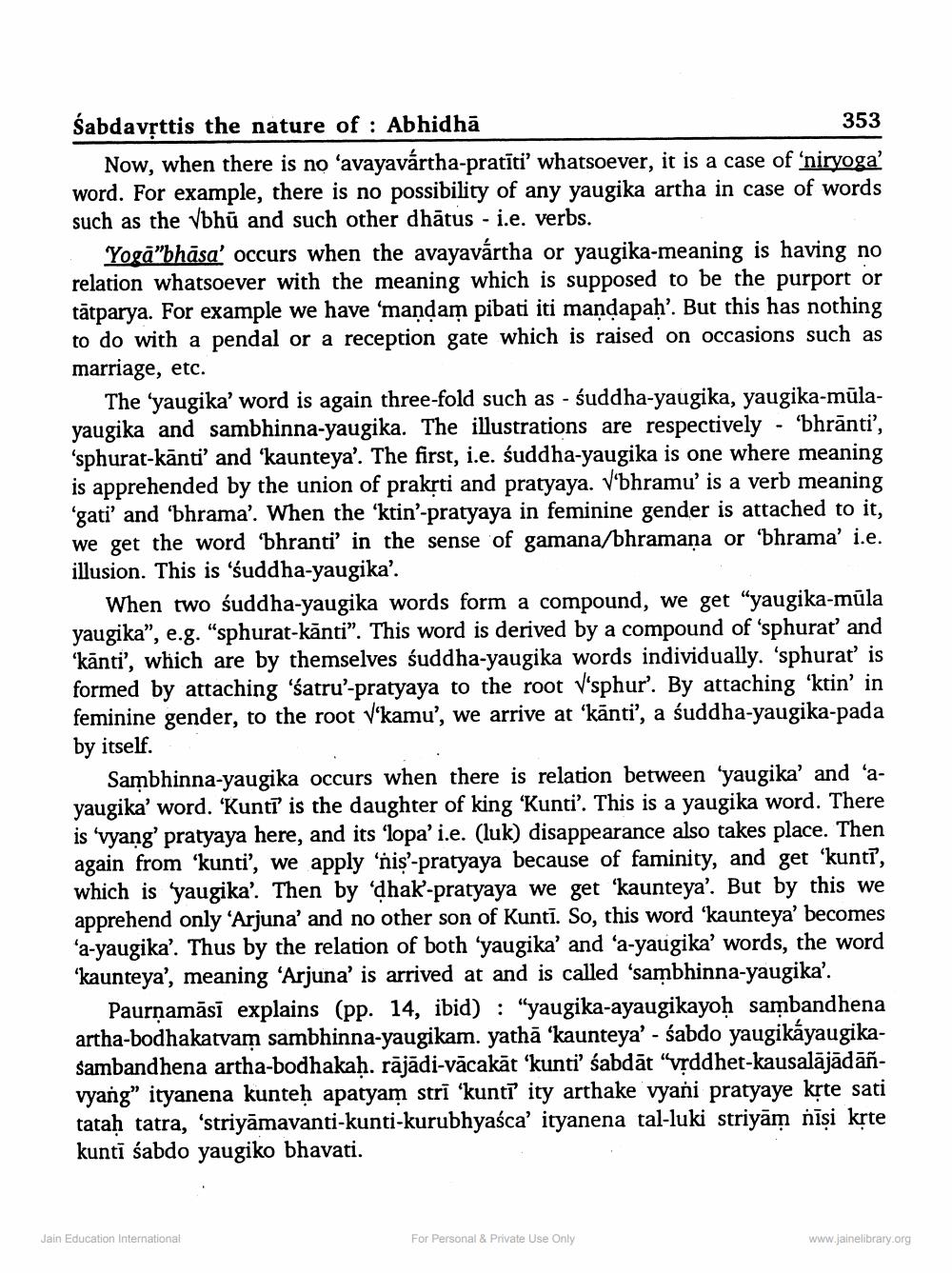________________
Sabdavrttis the nature of : Abhidhā
353 Now, when there is no ‘avayavártha-pratīti' whatsoever, it is a case of 'niryoga' word. For example, there is no possibility of any yaugika artha in case of words such as the Vbhū and such other dhātus - i.e. verbs.
Yogā”bhāsa' occurs when the avayavártha or yaugika-meaning is having no relation whatsoever with the meaning which is supposed to be the purport or tātparya. For example we have ‘mandam pibati iti mandapah'. But this has nothing to do with a pendal or a reception gate which is raised on occasions such as marriage, etc.
The 'yaugika' word is again three-fold such as - suddha-yaugika, yaugika-mulayaugika and sambhinna-yaugika. The illustrations are respectively - bhrānti', 'sphurat-kānti' and 'kaunteya’. The first, i.e. śuddha-yaugika is one where meaning is apprehended by the union of praksti and pratyaya. V'bhramu' is a verb meaning 'gati' and 'bhrama'. When the ‘ktin’-pratyaya in feminine gender is attached to it, we get the word 'bhranti' in the sense of gamana/bhramana or 'bhrama' i.e. illusion. This is 'śuddha-yaugika'.
When two śuddha-yaugika words form a compound, we get "yaugika-mūla yaugika”, e.g. "sphurat-kānti”. This word is derived by a compound of 'sphurat' and ‘kānti', which are by themselves śuddha-yaugika words individually. 'sphurat' is formed by attaching 'śatru’-pratyaya to the root V'sphur'. By attaching 'ktin'in feminine gender, to the root V'kamu', we arrive at 'kanti', a suddha-yaugika-pada by itself.
Sambhinna-yaugika occurs when there is relation between 'yaugika' and 'ayaugika' word. 'Kuntī is the daughter of king 'Kunti'. This is a yaugika word. There is 'vyang' pratyaya here, and its 'lopa' i.e. (luk) disappearance also takes place. Then again from ‘kunti', we apply 'nis'-pratyaya because of faminity, and get ‘kuntī, which is yaugika'. Then by dhak-pratyaya we get kaunteya'. But by this apprehend only 'Arjuna' and no other son of Kuntī. So, this word “kaunteya' becomes 'a-yaugika'. Thus by the relation of both 'yaugika' and 'a-yaugika' words, the word 'kaunteya', meaning 'Arjuna' is arrived at and is called 'sambhinna-yaugika'.
Paurņamāsī explains (pp. 14, ibid) : "yaugika-ayaugikayoḥ sambandhena artha-bodhakatvam sambhinna-yaugikam. yathā ‘kaunteya' - śabdo yaugikáyaugikasambandhena artha-bodhakah. rājādi vācakāt 'kunti' sabdāt "vrddhet-kausalājādāñvyang" ityanena kunteh apatyam stri 'kuntī ity arthake vyani pratyaye křte sati tatah tatra, 'striyāmavanti-kunti-kurubhyasca' ityanena tal-luki striyām nisi krte kunti sabdo yaugiko bhavati.
Jain Education International
For Personal & Private Use Only
www.jainelibrary.org




